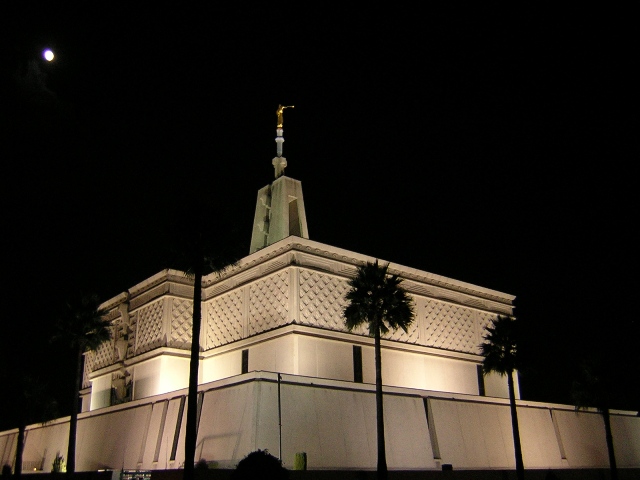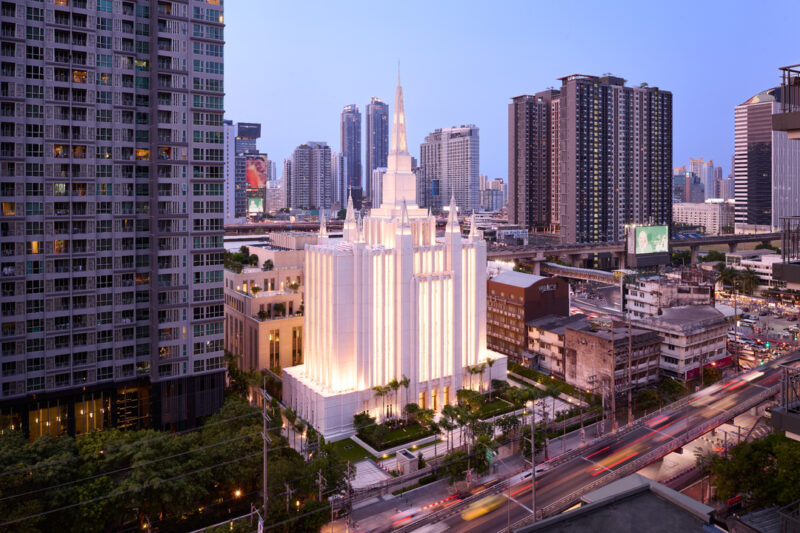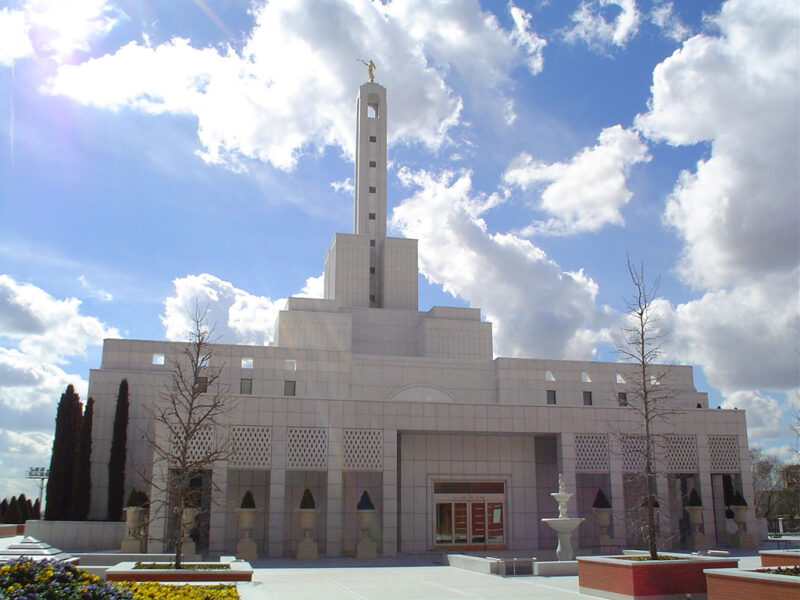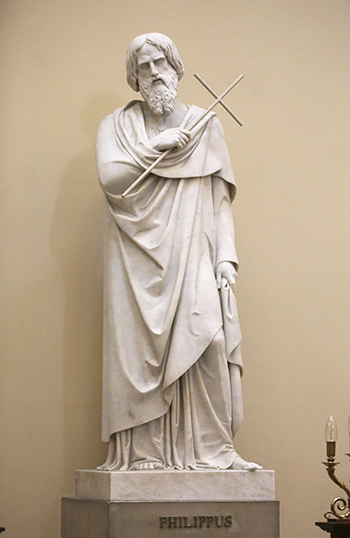Longtime readers may recall that I started to do a series on “temple architectural heritages” a while ago. I eventually aborted it since the subject was too big and unwieldy. Still, I’m looking forward to the day when somebody puts together a glossy coffee table book with not just pretty pictures, but also the architectural history and insights of all the different temple designs. (Although the excellent website churchofjesuschristtemples.org/ is close).
Still, I thought as a sort of coda to that enterprise I would provide a list of temples that, in my opinion, do a good job of incorporating unique, local styles into the general Latter-day Saint temple ur-style instead of using a standardized plan that’s been done a thousand times already.
This list is not comprehensive, and I’m sure I’ve missed some.
Japan, Sapporo
This recent addition to the Japanese landscape boasts a Zen Garden inside.

Mexico, Mexico City
Made in the Maya Revival style that includes Mayan and Aztec elements, so it kind of looks like an ancient Mesoamerican temple.

Bangkok, Thailand
“The design of the Bangkok Thailand Temple follows the patterns and colors found within Thai architecture. Many of these patterns overlay various diamond shapes with lotus flower elements and a herringbone pattern, evoking the weaved palms used in traditional arts and goods.”

Madrid, Spain
Mediterranean-looking vases in front and Arabesque diamond-patterned screens that are redolent of the Muslim-Spanish architecture.

Rome, Italy
According to Wikipedia patterned after a particular local Catholic church. Statues of the apostles in the traditional Roman/Catholic style, cross and all.

Dubai, United Arab Emirates
We haven’t seen the renditions of this one yet, but the potential of a temple that incorporates Islamic and/or Arab architectural themes and decor has some excited about the possibilities.

Comments
7 responses to “Temple Architecture and Local, Native Styles”
The Kiev temple was a missed opportunity. Many of the out-of -the-box temples simply incorporate some sort of local motif in the details such as the flower arrangements or painted moldings- maybe a stained glass pattern etc- usually local flora or crops.
But, as the church architects in the temple department copy elements of religious architecture from Shinto Temples, Catholic Missions, Kievian or Russian Orthodox onion domes, Islamic mosques or minarets, or the unique Shaker style (for Kentucky), it smacks of cultural appropriation. Which is worse, cultural appropriation or Utah-based imposed inculturation? We offer both.
We could avoid either by utilizing local lds architects and artists – the saints from all over the world in designing, crafting and building their own temples. Then, the cultural elements and local materials would naturally emerge- and a unique lds aesthetic.*
If you really want a coffee table book celebrating diversity- we need a much more diverse pool of architects. And, in the process we would again become a temple-building people. Right now, WE are not a temple-building people, THEY, a select few in the COB at 50 E North Temple are. And, even if they are brilliant architects, pressed to create at this rate, we get models a, b and c with slight tweaks. Stravinsky once critiqued the great Vivaldi saying he didn’t write 500 violin sonatas, but one sonata 500 times. The same jab was once levied against Scarlatti and his piano concertos. (Which is probably more deserved.) Vivaldi and Scarlatti were masters, but aren’t we glad western repertoire includes many others? I long for that diversity to emerge in our world-wide faith- in architecture, music, arts, as we hopefully learn to create and worship, not just plug and play.
*In following many conversations and writings from current and former church architects about the topic of cultural appropriation vs imposed Utah-based culture, I get the feeling that there isn’t a lot of trust that local architects. Partly, they know that there probably isn’t a LDS architectural firm in Star Valley WY (used as an example, but could apply in many places across the world) that could pull off a temple. But, even in great metropolises where there certainly is talent to function at this level, there’s a deep mistrust that local architects are capable of looking at their designs with these “macro” implications. They might (gasp) more myopically just charge ahead without thinking of the cultural implications. (Evidently a memo wouldn’t suffice.) As most church members who climb the leadership ladder learn to dress in a suit and tie, speak in conference voice, and emulate everything the Utah GAs do-, local architects (it is assumed) would just copy Utah culture or pioneer temples. This is quite a negative world-view! If you sit back and watch artists- the truly gifted ones- the great masters- and those inspired from on high, they exude brilliance and uniqueness. Great masters sing their own songs- they’ve risen above mere parroting.
Just a quick calculation…if we had Truman Angell when there were only 60k members in 1850, we should have 283 today with 17m members. So for each of the 109 planned temples, we have over 2 “Truman Angels” to pick from. Theoretically.
The Philadelphia temple would fit on this list. I suggest using Google street view positioned on Vine Street in front of the Parkway Central Library on the block west of the temple and look east toward the temple. You can even change the date of that view to 2012 or earlier when the temple site was a parking lot. The temple looks at home as though it’s been there a century but somehow has fresh clean walls.
Correction: The library is two blocks west of the Philadephia temple. Between the library and the temple is the Family Court Building, which was finished in 1941. But to get the sense of the Philadelphia temple’s place among its civic surroundings start with the Google street view in front of the library, then move the point of view east until the temple also enters the scene.
@Mortimer: Thank you for your thoughts. You clearly know more about this than I do.
@John Mansfield: I agree. While we moved before it was completed, we were in the Philadelphia area while it was being built and have done sessions in the Philadelphia Temple several times since, and I agree that it was a slam dunk in terms of incorporating the local styles while retaining a distinctive temple feel and architecture.
I would add the Tucson temple to the list. While in many ways it is a pretty standard cookie-cutter temple, the location blends into the Catalina foothills without disturbing the local community and the building eschews a traditional spire for a short blue dome that echoes older Catholic architecture in the area.
The plan for the Philadelphia temple was submitted to the city with three stories. The city asked for a fourth.
Ok, Stephen C., I’m hoping my next comment doesn’t cause a stir. I really have some cognitive dissonance about building a temple in Dubai, and I would balk at integrating traditionally Muslim religious architectural elements (like a minaret etc.) into the design.
Yes, I want temples to dot the earth. Yes, I want saints to have access to temples, yes, I want temples to be culturally, ecologically and geologically aligned. But, aside from the appropriation concern I mentioned above and despite my respect and appreciation for the rich Islamic history and the beautiful elements of this enormous faith, my concerns are many.
I don’t buy palm oil products from companies known to be the largest environmental abusers – on principle. When I married, I opted to not buy a non-ethically sourced diamond for a ring. ETB told us to “say no” to drugs in the ‘80’s not just because of the personal implications, but also because using drugs required others to participate in the trafficking of drugs which stained your hands with the blood of those who died. Additionally, selling was harmful others. Why do I worry about the ethical implications of my purchasing power if my church pays absolutely no heed to the much larger footprint of its coffers and choices?
What does it mean to symbolically, financially, and politically align with the UAE? Doesn’t it mean we accept a certain amount of tolerance for globally condemned women’s, LGBT and other human rights and free speech violations? Just because our conservative LDS culture gives us a certain type of alignment (that is celebrated and studied by many), I question what leaning into these similarities through this new temple arrangement means and what it represents to the members and the world. What ARE we leaning into and in the act, leaning away from? Polygamy? Trad wife roles? Free speech and expression? LGBT? Theocracy? Materialistic and wealth-oriented culture? Religiously-dominated modern life? Ugh.
I highly suspect that an Elder Kearson was brought into the Q15 specifically for his experience working as a communications exec in the middleast. I highly suspect there aren’t enough LDS ex-pats or UAE members to justify a temple in Dubai. I highly suspect that the UAE temple will need to be expensive and a gem in the pockets of the UAE’s rather Brigham-esque desire to build a divers religious presence in the shadow of its own. I also highly suspect that the heads in SLC feel that all these reasons to pause will be (in time)!inconsequential because planting a temple will bring spiritual transformation, enlightenment and change.
I wonder if we ought to be putting more of our hands and shoulders (and leveraging our purchasing power) into that goal rather than jumping in and hoping God does it all.
At any rate, I’m not sure that a minaret or Islamic motifs are the best architectural elements to incorporate t this time. As a female LDS still haunted by (as the illustrious Carol Lynn Pearson says) “the ghost of polygamy”, I don’t want to walk into a sacred building with the symbolism of modern polygamy written all over it.